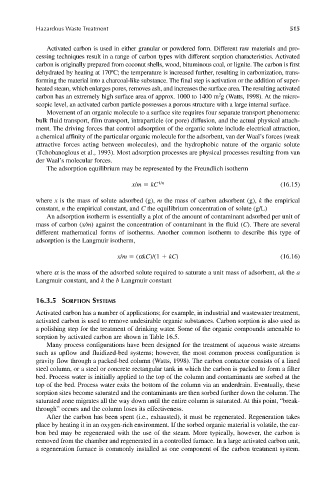Page 544 - Materials Chemistry, Second Edition
P. 544
CAT3525_C16.qxd 1/27/2005 12:42 PM Page 515
Hazardous Waste Treatment 515
Activated carbon is used in either granular or powdered form. Different raw materials and pro-
cessing techniques result in a range of carbon types with different sorption characteristics. Activated
carbon is originally prepared from coconut shells, wood, bituminous coal, or lignite. The carbon is first
dehydrated by heating at 170ºC; the temperature is increased further, resulting in carbonization, trans-
forming the material into a charcoal-like substance. The final step is activation or the addition of super-
heated steam, which enlarges pores, removes ash, and increases the surface area. The resulting activated
2
carbon has an extremely high surface area of approx. 1000 to 1400 m g (Watts, 1998). At the micro-
scopic level, an activated carbon particle possesses a porous structure with a large internal surface.
Movement of an organic molecule to a surface site requires four separate transport phenomena:
bulk fluid transport, film transport, intraparticle (or pore) diffusion, and the actual physical attach-
ment. The driving forces that control adsorption of the organic solute include electrical attraction,
a chemical affinity of the particular organic molecule for the adsorbent, van der Waal’s forces (weak
attractive forces acting between molecules), and the hydrophobic nature of the organic solute
(Tchobanoglous et al., 1993). Most adsorption processes are physical processes resulting from van
der Waal’s molecular forces.
The adsorption equilibrium may be represented by the Freundlich isotherm
x/m kC 1/n (16.15)
where x is the mass of solute adsorbed (g), m the mass of carbon adsorbent (g), k the empirical
constant, n the empirical constant, and C the equilibrium concentration of solute (g/L)
An adsorption isotherm is essentially a plot of the amount of contaminant adsorbed per unit of
mass of carbon (x/m) against the concentration of contaminant in the fluid (C). There are several
different mathematical forms of isotherms. Another common isotherm to describe this type of
adsorption is the Langmuir isotherm,
x/m (αkC)/(1 kC) (16.16)
where α is the mass of the adsorbed solute required to saturate a unit mass of adsorbent, ak the a
Langmuir constant, and k the b Langmuir constant
16.3.5 SORPTION SYSTEMS
Activated carbon has a number of applications; for example, in industrial and wastewater treatment,
activated carbon is used to remove undesirable organic substances. Carbon sorption is also used as
a polishing step for the treatment of drinking water. Some of the organic compounds amenable to
sorption by activated carbon are shown in Table 16.5.
Many process configurations have been designed for the treatment of aqueous waste streams
such as upflow and fluidized-bed systems; however, the most common process configuration is
gravity flow through a packed-bed column (Watts, 1998). The carbon contactor consists of a lined
steel column, or a steel or concrete rectangular tank in which the carbon is packed to form a filter
bed. Process water is initially applied to the top of the column and contaminants are sorbed at the
top of the bed. Process water exits the bottom of the column via an underdrain. Eventually, these
sorption sites become saturated and the contaminants are then sorbed further down the column. The
saturated zone migrates all the way down until the entire column is saturated. At this point, “break-
through” occurs and the column loses its effectiveness.
After the carbon has been spent (i.e., exhausted), it must be regenerated. Regeneration takes
place by heating it in an oxygen-rich environment. If the sorbed organic material is volatile, the car-
bon bed may be regenerated with the use of the steam. More typically, however, the carbon is
removed from the chamber and regenerated in a controlled furnace. In a large activated carbon unit,
a regeneration furnace is commonly installed as one component of the carbon treatment system.

